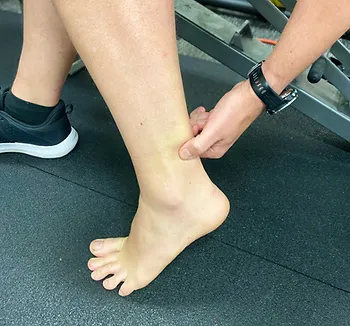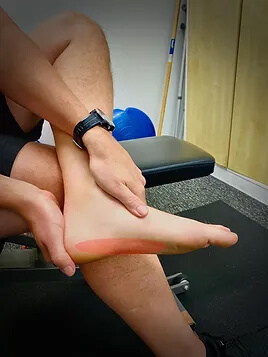Feel like your walking on glass in the mornings? Those first few steps after a long period of sitting hurt the underside of your heel? Struggling to stand at the end of a long day due to your feet? If so, then you may have plantar fasciopathy, also known as plantar fasciitis. Plantar fasciopathy is a common condition that affects the plantar fascia – a thick band of connective tissue on the bottom of the foot. Plantar fasciopathy commonly affects individuals between the ages of 40 and 60, but can affect almost anyone. In this article, we will delve into the causes, symptoms, treatment options, and preventive measures to help you understand, and more importantly manage, this condition.
Causes and Symptoms
Plantar fasciopathy is often caused by repetitive strain or excessive loading of the plantar fascia, leading to microtears and inflammation. Factors such as overuse, improper footwear, high-impact activities, flat or high-arched feet, and tight calf muscles can contribute to its development. The condition is characterised by sharp pain or a dull ache on the underside of the heel or along the arch of the foot. Pain is typically worse in the morning or after periods of inactivity, and may improve with movement. Standing for long periods or walking on hard floor can also be aggravating.
Treatment Options
The treatment of plantar fasciopathy focuses on reducing pain, promoting load tolerance, and addressing the underlying causes. Physiotherapy interventions play a crucial role in managing this condition. Therapeutic techniques such as manual therapy, stretching exercises, and strengthening exercises can help relieve pain, improve flexibility, and restore foot function. Specifically, improving the windlass mechanism (a phenomena that refers to the tightening of the plantar fascia during the push-off phase of walking or running when you big toe extends). This mechanism helps distribute forces evenly throughout the foot and reduces strain on the plantar fascia. More generally, improvement of the footy intrinsics and plantar flexors more generally have been shown to reduce the severity and duration of symptoms as well.
Additionally, the use of orthotics, taping, or night splints may provide support and alleviate symptoms. Extracorporeal shockwave therapy (ESWT) and ultrasound therapy are also viable treatment options in some cases. In severe or persistent cases, corticosteroid injections or surgery may be considered, though this is usually reserved for when conservative measures have failed.
Preventive Measures
Prevention is key to reducing the risk of plantar fasciopathy starting in the first instance. If you are keen to ‘pound the pavement’ for example, then gradually increase activity levels. Avoid sudden changes in intensity or duration to prevent overloading the foot. This may mean dancing long bouts for the first time in a while, or returning to running post injury. Wear footwear that provides adequate arch support and cushioning. Understand the importance of regular stretching exercises for the calf muscles and plantar fascia.
As physiotherapy professionals, we understand that addressing the symptoms of plantar fasciopathy early is essential for providing effective care. At Praxis, effective care means arming you with adequate advice and education so you can help manage the symptoms yourself. Further, implementing appropriate treatment options and emphasizing preventive measures, we support individuals in overcoming foot pain and restoring quality of life. After all, we aim to Prevent, Prepare, Perform! So if you have heel pain that is stopping you from doing what you would like to do, discuss it with our knowledgeable team today!
Until next time,
Praxis What You Preach!

Causes and Risks
Achilles tendinopathy typically results from a combination of intrinsic and extrinsic factors. Intrinsic factors include age, reduced flexibility, reduced calf strength / endurance and poor lower limb biomechanics. Extrinsic factors encompass inappropriate footwear, training errors (such as a spike or change in workload), and inadequate warm-up or cool-down routines. Additionally, individuals with systemic conditions like diabetes or rheumatoid arthritis may be more prone to developing Achilles tendinopathy. Understanding these factors is crucial for tailoring treatment plans to address the root causes and minimize the risk of recurrence. But in the most reductionist of terms, Achilles tendinopathy develops due in large part due to a mismatch between loading and the capacity of the tissue.
Diagnosis and Assessment
Accurate diagnosis of Achilles tendinopathy relies on a thorough clinical examination and patient history. Physiotherapists employ various assessment techniques, such as palpation, functional tests, and imaging modalities like ultrasound or MRI, to evaluate the severity and extent of the condition. A self administered questionnaire (VISA-A) can help evaluate symptoms and their effect on physical activity and in turn, the clinical severity. This comprehensive assessment helps determine the appropriate treatment approach, including targeted exercise programs, manual therapy, and other interventions.
Treatment Strategies
Physiotherapy plays a pivotal role in the management of Achilles tendinopathy. Treatment strategies focus on reducing pain, promoting healing, and improving function. These will include calf strengthening exercises, stretching routines and activity modification as frontline options. Moreover, physiotherapists can guide patients in proper footwear selection, gait retraining, and implementing preventive measures to minimize the risk of reinjury.
Rehabilitation and Prevention
Rehabilitation programs are essential for individuals recovering from Achilles tendinopathy. Gradual progression of exercise intensity, functional training, and sport-specific drills enable patients to regain strength, flexibility, and proprioception while minimizing the risk of relapse. Educating patients on proper warm-up and cool-down routines, appropriate footwear selection, and regular monitoring of training loads can significantly contribute to preventing Achilles tendinopathy in the future. One of the common errors patients make is making rehabilitation too easy, or returning to sport too quickly. Again, physiotherapy play a pivotal role in ensuring you undertake a graduated return to loading as the application of mechanical stress to the Achilles tendon promotes tendon healing and remodeling.
Conclusion
Achilles tendinopathy requires a comprehensive approach for effective management. As physiotherapists, our knowledge and expertise are invaluable in helping you overcome this condition and return to their active lifestyles. To discuss your Achilles issues with us to get you back to what you love doing, book online with Praxis today.
Until next time, Praxis What Your Preach.
Team Praxis

